|
|
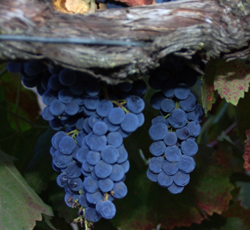 Harvest is not predictable even the California harvest. The best guess two months ago was that Cabernet Sauvignon from California would arrive mid-October. So we decided to squeeze a California trip in late September and early October to film vineyards and hopefully harvest. Unfortunately while we are flying to the west coast, the grapes already harvested are heading east. At least this is the case for Vint Hill Craft Winery in Virginia. Harvest is not predictable even the California harvest. The best guess two months ago was that Cabernet Sauvignon from California would arrive mid-October. So we decided to squeeze a California trip in late September and early October to film vineyards and hopefully harvest. Unfortunately while we are flying to the west coast, the grapes already harvested are heading east. At least this is the case for Vint Hill Craft Winery in Virginia.
Tin Lizzie Wineworks in Maryland is sourcing premium Cab from Stagecoach Vineyards in Napa. The current word is that harvest will occur around October 13th and grape arrival to the east about a week later.
We will miss one arrival and make the other. This must drive winemakers crazy, trying to adjust one’s schedule based on growers who are adjusting harvest due to many other variables. It is a wait and see situation. Hopefully we’ll capture some video of harvest in California. We are visiting wineries in Suisun, Lake County, Napa and Sonoma.
Photo shows California grapes nearing harvest.
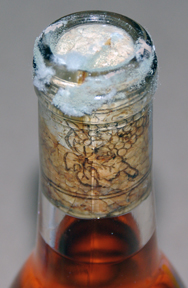 It is now a fact that I’ve learned more of “what not to do,” than what to do after making my first two batches of wine from kits. When checking the bottles in my wine cellar I came across one of my dessert Riesling bottles that had mold growing on it. It didn’t look good so I pulled it from its dark habitat and brought it to the kitchen for closer inspection. The cork closest to the wine was wet. Unfortunately the wetness proceeded all the way to the top of the cork on one side. The wine was slowly leaking. The high sugar content and darkness provided an ideal environment for mold to grow. It is now a fact that I’ve learned more of “what not to do,” than what to do after making my first two batches of wine from kits. When checking the bottles in my wine cellar I came across one of my dessert Riesling bottles that had mold growing on it. It didn’t look good so I pulled it from its dark habitat and brought it to the kitchen for closer inspection. The cork closest to the wine was wet. Unfortunately the wetness proceeded all the way to the top of the cork on one side. The wine was slowly leaking. The high sugar content and darkness provided an ideal environment for mold to grow.
I was reminded of what Phil Baily of Baily Vineyard and Winery told me during a tour of the winery facility in Temecula, California. Phil stated that cork is the best closure for wine bottles. It’s also the worst. Perhaps I should spend more money on enclosures.
So I opened the bottle to taste the wine. Its color was still a translucent yellow. It showed no signs of turning amber. The color in the photo is misleading. The aroma was definitely from the Riesling grape slightly floral and definitely fruity especially apple. If the wine is oxidizing it is in the very early stages. It was smooth and sweet although there was crispness on the finish and more tropical fruit on the aftertaste. Chris Pearmund of Peramund Cellars in Virginia told me that sugar is the winemaker’s secret ingredient. It can mask flaws in a wine. My wine was sweet enough to be very drinkable, fault or not. Perhaps looks can be deceiving.
I live by my calendar. Blocking out certain days is no concern, unless I don’t know when the days are. This is the case while waiting for the grapes to arrive at Vint Hill Craft Winery and Tin Lizzie Wineworks. We are at the mercy of the weather, harvest and shipment. Is there a way to get a ballpark idea of when the grapes may arrive?
Some growers and winemakers believe so. They talk about growing degree days for an educated guess of potential harvest. A degree day is the calculation of the difference between the average temperature for a day and 50. So if the average temperature for a day is 70º one would calculate 70 – 50 and the result 20 is the degree day for that date. Grapevines and grapes do not grow or mature much with temperatures less than 50º. For grapes, degree days are counted from April 1st through October 31st. Different grape varieties mature at different ranges of degree days.
Over the years the number of degree days vary by certain dates. This year Napa recorded 2,218 degree days by the middle of September. Last year they recorded that number by September 3rd. So that would put them about ten days or so behind where they were last year at this time. If you know when the grapes were harvested last year and you add ten days to last year’s date, you might predict about when the grapes will be harvested this year.
Will this reasoning work? There seem to be several variables at play here, one being the average temperatures after the middle of September. There is also the weather that may come into play. Many growers may decide to harvest a few days early if multi-inches of rain is on the way.
Dave Zuchero of Tin Lizzie Wineworks is predicting that Stagecoach vineyard in Napa may harvest the Cabernet Sauvignon the week of October 5th with delivery the week of October 12th. We’ll see how accurate this prediction turns out. Meanwhile, I’m ready, set and waiting.
If the first lesson didn’t convince me that this is a science class the second lesson certainly did. This lesson dealt with the preparation of the must and juice. In addition to the chemistry there was a healthy dose of math. I wonder if there is an iPhone app for winemakers.
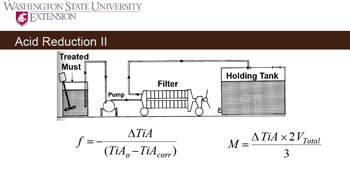 Several slides discussed creating the must. Then there were a number of slides presenting possible additions to the must including sugar, water, acid, sulfur dioxide, yeast, nutrients, enzymes and tannins. The slides were informative and basic until one reaches the acidity adjustments. Then the science kicks in and I kept trying to remember my high school chemistry class. The math was less of a challenge. One of the important things that I can take away from this lesson is the importance in testing the must. Tartaric acid should range between 6g/L and 10g/L while the pH should range between 3.1 and 3.7. If your must is within these ranges you’re in luck, if not you’ll have to add something to bring it within these ranges. It seems that adding tartaric acid to increase acidity may be easier than adding calcium carbonate to reduce acidity. In acid reduction, one must calculate how much of the must to treat and how much to treat it with. Eight slides out of 44 were devoted to acidity. Several slides discussed creating the must. Then there were a number of slides presenting possible additions to the must including sugar, water, acid, sulfur dioxide, yeast, nutrients, enzymes and tannins. The slides were informative and basic until one reaches the acidity adjustments. Then the science kicks in and I kept trying to remember my high school chemistry class. The math was less of a challenge. One of the important things that I can take away from this lesson is the importance in testing the must. Tartaric acid should range between 6g/L and 10g/L while the pH should range between 3.1 and 3.7. If your must is within these ranges you’re in luck, if not you’ll have to add something to bring it within these ranges. It seems that adding tartaric acid to increase acidity may be easier than adding calcium carbonate to reduce acidity. In acid reduction, one must calculate how much of the must to treat and how much to treat it with. Eight slides out of 44 were devoted to acidity.
The lesson then turned to the addition of sulfur dioxide that can have both positive and negative effects. Both the molecular form of sulfur dioxide and the bisulfite form were discussed. How much the winemaker adds depends on why it needs to be added.
The next set of slides looked at adding yeast and yeast nutrients. The presentation continued with enzyme and tannin additions. The lesson concluded with pressing.
This lesson was too much science and math unless you plan to work in the lab where you will be testing the must and calculating what and how much to add. The lesson was informative but aimed at the winemaker who has to perform the tests and calculations. Most clients at Vint Hill Craft Winery and Tin Lizzie Wineworks will leave these tasks in the hands of the winemakers. I, for one always liked my chemistry class. So I plan to spend some time in the lab.
In Fall of 2008 I made 2.5 gallons of mead. For months it was cloudy and research basically suggested to “leave it alone. It will eventually clear.” This summer it cleared so I decided to bottle the mead today. The mead is somewhat special to me. It was my first attempt to make wine that was not from a kit. It seemed to work fine; so wine kits may well be a thing of the past.
This is just a plain mead. I didn’t add fruit or flavoring. I wanted to capture the taste of the place where the honey was made. The mead ended dry, about 14% alcohol and 0% RS. It has a floral and honey aroma and honey taste. There is a long honey aftertaste that lingers. After have a glass or two it does grow on you; I’m not an avid mead drinker.
If I make another batch of mead, I’d like to add raspberries for some fruit flavoring. This particular mead pairs nicely with spicy hot cheeses. It helps cut the spiciness and the cheese cuts the aftertaste of the mead. I’d like to experiment using some of the mead in cooking especially with pork and chicken.
Since I knew that I was going to craft a barrel of wine during the fall of 2009, I decided to take an online class on winemaking. There are several online classes on winemaking and viticulture offered by Washington State University Extension. The class, Introduction to Winemaking, consists of seven lessons accompanied by a Powerpoint-type presentation and narrated by Dr. James F. Harbertson, an Extension Enologist.
I began to take the classes in March and quickly decided to put them off until September and October. It didn’t take long to determine that the classes were heavy into the science and having access to a real lab at the wineries will make the classes more enjoyable than some virtual lab in my imagination.
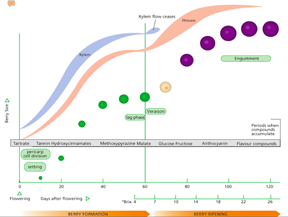 The first lesson was an overview of winemaking and determining ripeness. It didn’t cover much about winemaking at all other than what a winemaker would like to have in grapes that reach the winery. The majority of this lesson was about the vineyard and the development of grapes. Several slides were devoted to determining ripeness. The first lesson was an overview of winemaking and determining ripeness. It didn’t cover much about winemaking at all other than what a winemaker would like to have in grapes that reach the winery. The majority of this lesson was about the vineyard and the development of grapes. Several slides were devoted to determining ripeness.
My general impression of the lesson is that it covered the vineyard, grape development and when to harvest in a much broader and deeper context than the class at Vint Hill Craft Winery. Would people crafting a barrel of wine benefit from the first lesson in the winemaking class? I believe so if they are into the science behind what they are doing or about to do. The lesson did however cause concern.
A winemaker who has access to a vineyard can go into the vineyard after veraison and test for sugar and acidity. When the vineyard is thousands of miles away, one is somewhat at the mercy of the grower. True a winemaker who receives less than desirable grapes can choose a different grower the following year, so there is some market control for quality. However if people are going to only craft one barrel of wine, they have to take what they receive. Herein lies a certain degree of worry. What will the grapes be like?
The lesson discussed the ranges for brix (the measure of sugar) and acidity. There are two measures dealing with the acidity, TA that is the concentration of acidity in grams per liter and pH (remember high school chemistry class). When my grapes arrive at Vint Hill Craft Winery in Virginia and Tin Lizzie Wineworks in Maryland, I’ll test to determine the degree of brix, TA and pH. This data will hopefully prove valuable for making decisions.
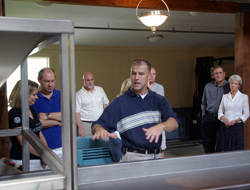 Kathy and I attended our first winemaking class at Vint Hill Craft Winery presented by winemaker, DJ Leffin. DJ has an easy going manner and blended well with the more than twenty participants. Using a PowerPoint presentation, DJ gave a crash course on the vineyard and the winemaking process. At times, we left the teaching area to view the equipment. “Nothing is so important that it has to be done right now,” commented DJ as he discussed the importance of safety while in the winery. The content for the first class was much of the same content I wrote for two learning modules on the Wine Trail Traveler site: Kathy and I attended our first winemaking class at Vint Hill Craft Winery presented by winemaker, DJ Leffin. DJ has an easy going manner and blended well with the more than twenty participants. Using a PowerPoint presentation, DJ gave a crash course on the vineyard and the winemaking process. At times, we left the teaching area to view the equipment. “Nothing is so important that it has to be done right now,” commented DJ as he discussed the importance of safety while in the winery. The content for the first class was much of the same content I wrote for two learning modules on the Wine Trail Traveler site:
The Vineyard is a short fourteen-slide module about growing grapes.
Winemaking is a module that describes the winemaking process for red and white wines.
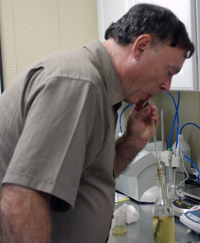 After the class, many of the participants headed to the tasting room to taste wines. Kathy and I headed to the lab to test the sulfite (sulphite) levels in a mead I am ready to bottle. My question was whether I should add sulfite to the mead. The testing process quickly reminded me of high school chemistry class. Yes, I can still remember that class even though I took it decades ago. DJ spoke of the importance of exact measurement and noted that the graduated beakers were not accurate. Using a 10 ml pipette, I transferred 50 ml to a beaker. Sure enough, it was different than the mark on the glass. Next DJ added some solution and powder than placed the beaker under probes from a machine. The sulfite levels were over 150 ppm. Chris Pearmund, partner and executive winemaker at Vint Hill Craft Winery stopped by and stated that most people who make meads do not add sulfites before bottling. So I’ll bottle without adding sulfites. After the class, many of the participants headed to the tasting room to taste wines. Kathy and I headed to the lab to test the sulfite (sulphite) levels in a mead I am ready to bottle. My question was whether I should add sulfite to the mead. The testing process quickly reminded me of high school chemistry class. Yes, I can still remember that class even though I took it decades ago. DJ spoke of the importance of exact measurement and noted that the graduated beakers were not accurate. Using a 10 ml pipette, I transferred 50 ml to a beaker. Sure enough, it was different than the mark on the glass. Next DJ added some solution and powder than placed the beaker under probes from a machine. The sulfite levels were over 150 ppm. Chris Pearmund, partner and executive winemaker at Vint Hill Craft Winery stopped by and stated that most people who make meads do not add sulfites before bottling. So I’ll bottle without adding sulfites.
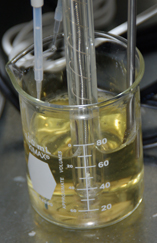 It was an interesting day. The chemistry in a wine lab is much more interesting than the chemistry in a high school lab. It was an interesting day. The chemistry in a wine lab is much more interesting than the chemistry in a high school lab.
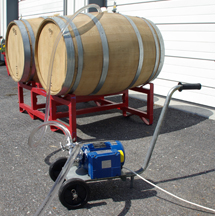
I always fancied vineyards, winemaking and wine as romantic. Vineyard weddings or proposals field this view. So do winery receptions and bridal parties. Wine can always be romantic. However there is another side to the process from the vineyard to your glass that is not romantic.
My first day spent working at Tin Lizzie Wine Works was a good example of reality. The first task was to empty the liquid from two barrels. Not at hard task, connect the small pump to electricity, attach two hoses and turn the on switch in the direction of the flow. After the pump emptied what it could I turned the barrels 180º to drain the last of the liquid. Nothing was very romantic about the procedure.
The next task was to paint the cement floor in the winemaking area. First everything had to be moved out. Then the floor was swept and washed. Around the perimeter the washing was on hands and knees. After it dried it was painted with a cement paint. Again the perimeter was on hands and knees but everything else was with a roller. This was not a very romantic task, but the area looked nice and reminded me of painting my parents’ garage floor in my youth.
I once was told there were over a thousand decisions that go into making a bottle of wine. I suspect that the vast majority is not very romantic. I’ll chronicle many of the winemaker’s tasks over the next several months. For now it’s prepare for crush cleaning.
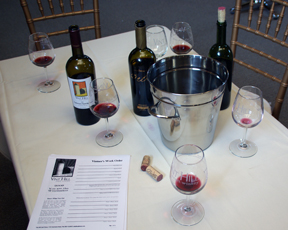 It is always easier to drive to a location if you know the route. Chances are you won’t get lost along the way. Winemaking is similar. If you know what you are looking for, you can craft the wine towards that destination. In July we met with Chris Pearmund, co-owner of Vint Hill. The purpose of this meeting was to discuss the type of wine we would like to make. I took two bottles of wine with me. One was the Cab that I made a year ago and the other was a 2004 Cab from Doffo Winery in Temecula, Ca. Chris provided a Cabernet Sauvignon he bottled with a Vint Hill label. I took my Cabernet Sauvignon as an example of what I didn’t want my wine to turn out as. It is always easier to drive to a location if you know the route. Chances are you won’t get lost along the way. Winemaking is similar. If you know what you are looking for, you can craft the wine towards that destination. In July we met with Chris Pearmund, co-owner of Vint Hill. The purpose of this meeting was to discuss the type of wine we would like to make. I took two bottles of wine with me. One was the Cab that I made a year ago and the other was a 2004 Cab from Doffo Winery in Temecula, Ca. Chris provided a Cabernet Sauvignon he bottled with a Vint Hill label. I took my Cabernet Sauvignon as an example of what I didn’t want my wine to turn out as.
We sampled the wines and discussed them. I had a list of goals that I’d like to accomplish in crafting a barrel of wine. During the wine tasting I was able to also say what I did not want my wine to turn out as. One of my goals is to craft a wine to be fruit forward. I do not care for Cabernet Sauvignon grapes that were harvested early and under ripe with their vegetative aroma and taste. I prefer the fruit aroma and taste over the more ripe Cab grapes that develop a jam aroma and taste. Regarding alcohol, I’d like to be around 14%. Chris suggested that we aim for 14 ½% because some of the alcohol will evaporate during the months the wine is aging in barrels. I also want the wine to have noticeable tannins that are soft. I’d like to go with French oak barrels and extend the barrel aging by several months. Chris made some suggestions such as post fermentation maceration that will help achieve the goal of the fruity aroma and taste.
This meeting was beneficial. It provided a means of communicating what the finish wine I’d like to create would be like and Chris was able to talk about what we could do in this state of the art wine to achieve those goals.
If you are interested in making a barrel of wine at Vint Hill Craft Winery, your first decisions will be made when you complete the Vintner’s Work Order. Think of this as an application where you make some early decisions about the wine you want to craft. Your first decision is to select the grape(s) you’d like to use to make your wine. For the 2009 harvest you can choose between: Chardonnay, Viognier, Cabernet Franc, Cabernet Sauvignon, Merlot and Petite Verdot from Virginia, or Cabernet Sauvignon, Merlot, Petit Syrah, Syrah and Zinfandel from California. If you are interested in a variety not mentioned, you can request it and the winery will attempt to acquire it. Some of the grape varieties have an additional charge such as Virginian Viognier and Petit Verdot and Californian Cabernet Sauvignon.
Your next decision is to determine what type of barrel you will use. Your choices include barrels made from Virginian, American, Hungarian or French oak. Each of these will add to your cost with the French oak barrels costing the most. The last decision is whether you want to add on different winemaking techniques that can affect your wine. Each of these will increase the cost of the wine. You can choose an extended cold soaking, post-fermentation maceration and additional six to ten months of barrel aging.
Based on your decisions, you will have an idea of the cost to create a barrel of wine. Price of the finished wine will range from lows around $20 per bottle to highs around $33 per bottle. You will bottle between 23 and 25 cases of wine, so another decision you can make is to make the barrel of wine by yourself or as a group. Making the wine as a group will certainly lower your cost and will lower the number of cases you will have after bottling. With the 2009 harvest, bottling will not take place until 2010 and if you decide to extend the barrel aging bottling may not take place until 2011.
|
|
 Harvest is not predictable even the California harvest. The best guess two months ago was that Cabernet Sauvignon from California would arrive mid-October. So we decided to squeeze a California trip in late September and early October to film vineyards and hopefully harvest. Unfortunately while we are flying to the west coast, the grapes already harvested are heading east. At least this is the case for Vint Hill Craft Winery in Virginia.
Harvest is not predictable even the California harvest. The best guess two months ago was that Cabernet Sauvignon from California would arrive mid-October. So we decided to squeeze a California trip in late September and early October to film vineyards and hopefully harvest. Unfortunately while we are flying to the west coast, the grapes already harvested are heading east. At least this is the case for Vint Hill Craft Winery in Virginia. It is now a fact that I’ve learned more of “what not to do,” than what to do after making my first two batches of wine from kits. When checking the bottles in my wine cellar I came across one of my dessert Riesling bottles that had mold growing on it. It didn’t look good so I pulled it from its dark habitat and brought it to the kitchen for closer inspection. The cork closest to the wine was wet. Unfortunately the wetness proceeded all the way to the top of the cork on one side. The wine was slowly leaking. The high sugar content and darkness provided an ideal environment for mold to grow.
It is now a fact that I’ve learned more of “what not to do,” than what to do after making my first two batches of wine from kits. When checking the bottles in my wine cellar I came across one of my dessert Riesling bottles that had mold growing on it. It didn’t look good so I pulled it from its dark habitat and brought it to the kitchen for closer inspection. The cork closest to the wine was wet. Unfortunately the wetness proceeded all the way to the top of the cork on one side. The wine was slowly leaking. The high sugar content and darkness provided an ideal environment for mold to grow. Several slides discussed creating the must. Then there were a number of slides presenting possible additions to the must including sugar, water, acid, sulfur dioxide, yeast, nutrients, enzymes and tannins. The slides were informative and basic until one reaches the acidity adjustments. Then the science kicks in and I kept trying to remember my high school chemistry class. The math was less of a challenge. One of the important things that I can take away from this lesson is the importance in testing the must. Tartaric acid should range between 6g/L and 10g/L while the pH should range between 3.1 and 3.7. If your must is within these ranges you’re in luck, if not you’ll have to add something to bring it within these ranges. It seems that adding tartaric acid to increase acidity may be easier than adding calcium carbonate to reduce acidity. In acid reduction, one must calculate how much of the must to treat and how much to treat it with. Eight slides out of 44 were devoted to acidity.
Several slides discussed creating the must. Then there were a number of slides presenting possible additions to the must including sugar, water, acid, sulfur dioxide, yeast, nutrients, enzymes and tannins. The slides were informative and basic until one reaches the acidity adjustments. Then the science kicks in and I kept trying to remember my high school chemistry class. The math was less of a challenge. One of the important things that I can take away from this lesson is the importance in testing the must. Tartaric acid should range between 6g/L and 10g/L while the pH should range between 3.1 and 3.7. If your must is within these ranges you’re in luck, if not you’ll have to add something to bring it within these ranges. It seems that adding tartaric acid to increase acidity may be easier than adding calcium carbonate to reduce acidity. In acid reduction, one must calculate how much of the must to treat and how much to treat it with. Eight slides out of 44 were devoted to acidity. The first lesson was an overview of winemaking and determining ripeness. It didn’t cover much about winemaking at all other than what a winemaker would like to have in grapes that reach the winery. The majority of this lesson was about the vineyard and the development of grapes. Several slides were devoted to determining ripeness.
The first lesson was an overview of winemaking and determining ripeness. It didn’t cover much about winemaking at all other than what a winemaker would like to have in grapes that reach the winery. The majority of this lesson was about the vineyard and the development of grapes. Several slides were devoted to determining ripeness. Kathy and I attended our first winemaking class at Vint Hill Craft Winery presented by winemaker, DJ Leffin. DJ has an easy going manner and blended well with the more than twenty participants. Using a PowerPoint presentation, DJ gave a crash course on the vineyard and the winemaking process. At times, we left the teaching area to view the equipment. “Nothing is so important that it has to be done right now,” commented DJ as he discussed the importance of safety while in the winery. The content for the first class was much of the same content I wrote for two learning modules on the Wine Trail Traveler site:
Kathy and I attended our first winemaking class at Vint Hill Craft Winery presented by winemaker, DJ Leffin. DJ has an easy going manner and blended well with the more than twenty participants. Using a PowerPoint presentation, DJ gave a crash course on the vineyard and the winemaking process. At times, we left the teaching area to view the equipment. “Nothing is so important that it has to be done right now,” commented DJ as he discussed the importance of safety while in the winery. The content for the first class was much of the same content I wrote for two learning modules on the Wine Trail Traveler site: After the class, many of the participants headed to the tasting room to taste wines. Kathy and I headed to the lab to test the sulfite (sulphite) levels in a mead I am ready to bottle. My question was whether I should add sulfite to the mead. The testing process quickly reminded me of high school chemistry class. Yes, I can still remember that class even though I took it decades ago. DJ spoke of the importance of exact measurement and noted that the graduated beakers were not accurate. Using a 10 ml pipette, I transferred 50 ml to a beaker. Sure enough, it was different than the mark on the glass. Next DJ added some solution and powder than placed the beaker under probes from a machine. The sulfite levels were over 150 ppm. Chris Pearmund, partner and executive winemaker at Vint Hill Craft Winery stopped by and stated that most people who make meads do not add sulfites before bottling. So I’ll bottle without adding sulfites.
After the class, many of the participants headed to the tasting room to taste wines. Kathy and I headed to the lab to test the sulfite (sulphite) levels in a mead I am ready to bottle. My question was whether I should add sulfite to the mead. The testing process quickly reminded me of high school chemistry class. Yes, I can still remember that class even though I took it decades ago. DJ spoke of the importance of exact measurement and noted that the graduated beakers were not accurate. Using a 10 ml pipette, I transferred 50 ml to a beaker. Sure enough, it was different than the mark on the glass. Next DJ added some solution and powder than placed the beaker under probes from a machine. The sulfite levels were over 150 ppm. Chris Pearmund, partner and executive winemaker at Vint Hill Craft Winery stopped by and stated that most people who make meads do not add sulfites before bottling. So I’ll bottle without adding sulfites. It was an interesting day. The chemistry in a wine lab is much more interesting than the chemistry in a high school lab.
It was an interesting day. The chemistry in a wine lab is much more interesting than the chemistry in a high school lab.
 It is always easier to drive to a location if you know the route. Chances are you won’t get lost along the way. Winemaking is similar. If you know what you are looking for, you can craft the wine towards that destination. In July we met with Chris Pearmund, co-owner of Vint Hill. The purpose of this meeting was to discuss the type of wine we would like to make. I took two bottles of wine with me. One was the Cab that I made a year ago and the other was a 2004 Cab from Doffo Winery in Temecula, Ca. Chris provided a Cabernet Sauvignon he bottled with a Vint Hill label. I took my Cabernet Sauvignon as an example of what I didn’t want my wine to turn out as.
It is always easier to drive to a location if you know the route. Chances are you won’t get lost along the way. Winemaking is similar. If you know what you are looking for, you can craft the wine towards that destination. In July we met with Chris Pearmund, co-owner of Vint Hill. The purpose of this meeting was to discuss the type of wine we would like to make. I took two bottles of wine with me. One was the Cab that I made a year ago and the other was a 2004 Cab from Doffo Winery in Temecula, Ca. Chris provided a Cabernet Sauvignon he bottled with a Vint Hill label. I took my Cabernet Sauvignon as an example of what I didn’t want my wine to turn out as.

